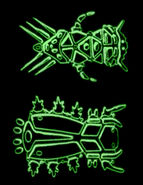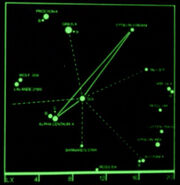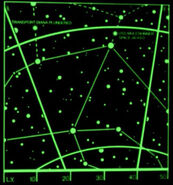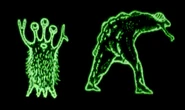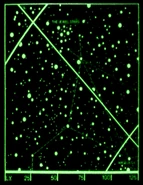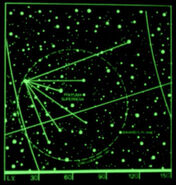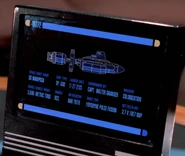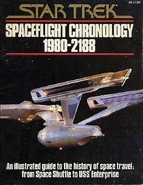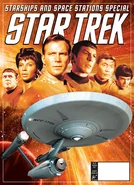m (it's -> its) |
m (corr.) Tag: sourceedit |
||
| (48 intermediate revisions by 17 users not shown) | |||
| Line 1: | Line 1: | ||
| + | {{realworld}} |
||
| − | {| class="wiki-sidebar" |
||
| + | {{Sidebar reference book| |
||
| − | |- |
||
| + | | image = Star Trek Spaceflight Chronology.jpg |
||
| − | | colspan="2" style="text-align: center" | [[Image:STSFChrono.jpg|200px|Book Cover]] |
||
| + | | Author = [[Stanley Goldstein|Stanley]] and [[Fred Goldstein]] |
||
| − | |- |
||
| + | | Artist = [[Rick Sternbach]] |
||
| − | | class="odd" | Author(s): |
||
| + | | Publisher = [[Pocket Books|Wallaby Books]]<br/>[[Phoebus]] (UK) |
||
| − | | class="even" | [[Stanley Goldstein|Stanley]] and [[Fred Goldstein]] |
||
| + | | Published = {{d|24|December|1979}} |
||
| − | |- |
||
| + | | Pages = 192<br/>64 (UK) |
||
| − | | class="odd" | Illustrator(s): |
||
| + | | ISBN = 0671790897 (both editions) |
||
| − | | class="even" | [[Rick Sternbach]] |
||
| + | }} |
||
| − | |- |
||
| + | The '''''Star Trek Spaceflight Chronology''''' is a [[reference book]] which catalogs mankind's technological endeavors into space, spanning the period from the launch of the first artificial satellite, ''[[Sputnik I]]'', to the events depicted in {{film|1}}, and the technology developed along the way. As such, it is a mixture of real-world events up until the [[space shuttle]] in 1980, and conjectural events afterwards, some of which were depicted or referenced to during the run of ''[[Star Trek: The Original Series]]''. |
||
| − | | class="odd" | Published: |
||
| − | | class="even" | 1980 |
||
| − | |- |
||
| − | | class="odd" | Pages: |
||
| − | | class="even" | 192 |
||
| − | |- |
||
| − | | class="odd" | Reference #: |
||
| − | | class="even" | ISBN 0671790897 |
||
| − | |} |
||
| − | The '''''Star Trek Spaceflight Chronology''''' by [[Stanley Goldstein|Stanley]] and [[Fred Goldstein]], with illustrations by [[Rick Sternbach]]. was published in 1980 and describes the history of ''[[Star Trek]]'' making use of a [[timeline]] and illustrations which are now considered by most to be outside of [[canon]], as they have been contradicted by information presented since its publication, starting with [[TNG Season 1]]. |
||
| + | ==Summary== |
||
| − | As the primary source available until TNG Season 1, this it was used as a model for the [[FASA]] role-playing [[games]], and a few [[novels]]. It was also used as a reference by the writers of [[Star Trek: The Next Generation|''The Next Generation'']]. |
||
| + | ;From the book jacket (US) |
||
| + | :''The stars beckon... man responds! The human adventure is just beginning!'' |
||
| + | :''The publication of this book initiates an exciting and necessary project: to provide Star Fleet Academy Cadets with a concise illustrated history of their home planets, spaceflight, evolution and development.'' |
||
| − | In addition to newly created starships found only within this volume, the chronology offered specifications for canon vessels such as the [[USS Enterprise (XCV 330)|USS ''Enterprise'' (XCV 330)]] and [[DY-100 class|''DY-100'' class]]. |
||
| + | :''So, Cadets from Earth, welcome to the history of your planet's two and a half illustrious centuries in space – years filled with extraordinary achievement, darkened by great tragedy, marked by countless marvels and perils. The future will be made by you who read this chronology.'' |
||
| − | == Timeline == |
||
| − | The timeline presented in the book was as follows: |
||
| + | :''Learn the past to make the future.'' |
||
| − | === 20th Century === |
||
| − | ;[[1980]] : [[Space shuttle]] flights begin as available payload space is booked full. Early missions will demonstrate the many uses of the [[gravity]]-free vacuum of [[space]]. |
||
| − | ;[[1982]] : [[Luna]]r Polar Orbiter transmits data concerning surface chemistry and heat flow on the moon. |
||
| − | : Project Galileo departs from [[Earth]] [[orbit]] for [[Jupiter]]. It will descend into the Jovian atmosphere behind a heat shield, radioing back data until the increasing pressure crushes the [[hull]], about 30 minutes after entry. |
||
| − | ;[[1983]] : The Space Telescope is orbited. This 2.4m aperture optical telescope, working above atmospheric turbulence, will revolutionize man's view of the universe. |
||
| − | : The [[Venus]] Atmospheric [[Balloon]] enters the Venusian atmosphere, sending back data from its gondola of scientific instruments; it circles the planet on the stratospheric winds for several days. |
||
| − | ;[[1985]] : [[Probe]] flies by [[Halley's Comet]] with a battery of instruments that measure its tenuous tail, and continues on to encounter [[comet]] Tempel 2 in [[1988]]. |
||
| − | ;[[1986]] : Multiple [[Asteroid]] Rendezvous Mission will view these bodies in space close-up with an eye on the future mining of these interplanetary travelers. |
||
| − | ;[[1988]] : [[Mars]] Sample Return Probe is launched. It will retrieve soil and rocks for analysis back on Earth when it returns in [[1991]]. |
||
| − | ;[[1991]] : The [[Saturn]] Dual Probe arrives at the planet, with the [[satellite]] going into orbit as the descent stage relays information as it enters the planet's [[atmosphere]]. |
||
| − | ;[[1992]] : The space shuttle completes its twelve-year series so successfully, man will forever be in space. |
||
| − | ;[[1994]] : Manned missions to the moon begin again with several nations taking part. Cooperating as never before, they have a goal of building a permanent moon base by the [[2001|turn of the century]]. |
||
| − | ;[[1996]] : The [[DY-100]] is the first mass-produced space ship capable of short interplanetary travel (Earth-moon). In an uprated mode, it will be able to take men to Mars. |
||
| − | ;[[1998]] : Goddard Moonbase, the first large scale international space project, will provide accommodations for 70 in the fields of space research and industry. |
||
| − | ;[[1999]] : Asteroid Belt Lander reveals asteroids to be rich in important raw materials for further space industrialization. |
||
| + | :''Live long and prosper!'' |
||
| − | ===21st Century=== |
||
| − | ;[[2001]] : [[Mercury (planet)|Mercury]] Rover sends back first soil sample information from its location at terminator. Data obtained is from both dark side and light side of planet. |
||
| − | ;[[2002]] : Construction begins on the first city in space. This is by far man's largest undertaking off the Earth to date. |
||
| − | : [[United Nations|UN]] study shows space industry will grow at exponential rate over next 15 years. |
||
| − | ;[[2003]] : The United Space Initiative is signed in [[New York City|New York]]. This landmark agreement will focus and accelerate man's exploration of the [[Sol system|Solar System]] for the benefit of all mankind. |
||
| − | ;[[2004]] : Farside Moonbase begins operations. Will specialize in radio telescope observations. |
||
| − | : First major expansion of the Goddard Moonbase. |
||
| − | : Mass Driver in use at Clavius Mines. Raw materials are shot back to Earth orbit for processing to feed burgeoning industry. |
||
| − | ;[[2005]] : The first spacechild is born at the Farside Moonbase. This event is heralded the world over as a new generation of man has begun. |
||
| − | ;[[2006]] : Thomas Morrison, the first person to die on the moon, is buried in a simple grave marking this historic occasion. |
||
| − | ;[[2007]] : Marking the 50th anniversary of the space age, the most comprehensive encyclopedia of space exploration is published. |
||
| − | : Tsiolkovskygrad, the first [[Lagrange point|L-5]] city in space, is completed. 250 people take up residence. |
||
| − | ;[[2008]] : ''Aventeur''-class enters service. It is the first ship to be entirely assembled in Earth orbit. |
||
| − | : Fusion power research and development brings forth the ultimate recycling device, the Fusion Torch, a furnace so hot that it can melt down all materials, artificial and natural, to their basic state. |
||
| − | ;[[2009]] : Second L-5 city in space opens. Five more to be built in following decade. |
||
| − | ;[[2010]] : First Earth/Space Census shows 1,500 people living off the Earth. As many as 7,500 could be in space by the year 2020, UN study shows. |
||
| − | : Solar now accounts for 40% [[United States of America|US]] energy use. Worldwide accelerated Solar Power Satellite program will be completed this decade. |
||
| − | ;[[2012]] : Marsbase 1, the first interplanetary outpost, begins the first thorough search for extraterrestrial life. |
||
| − | ;[[2013]] : The DY-300, successor to the DY-100, undergoes prototype testing. This design has some serious flaws which prevent it from entering service. |
||
| − | ;[[2014]] : First manned Jupiter Mission is farthest journey from Earth. |
||
| − | : The Space Homesteading Act affords enterprising pioneers the opportunity to acquire property in the Solar System. From its beginnings, the Act proves to be popular and workable. |
||
| − | ;[[2015]] : Marsbase 2 expands the search for extraterrestrial life. |
||
| − | : The first interstellar probes, the Stellar Series, are launched towards the nearby stars. This series ends in [[2022]]. |
||
| − | ;[[2017]] : UNSS ''U-Thant'' reports large amounts of [[antimatter]] in interstellar void. This startling discovery subsequently changes the course of space-flight technology decades later. |
||
| − | ;[[2018]] : From Marsbase 3 begins an in-depth study on using Phobos and Deimos for mining of materials. |
||
| − | : The first homesteaders begin leaving for the Asteroid Belt. |
||
| − | ;[[2019]] : On 50th anniversary of the first manned mission to the moon, all six original [[Apollo 11|Apollo]] landing sites become historic landmarks. |
||
| − | : On Phobos, the larger Martian moon, a temporary base is set up as first mining activity begins. |
||
| − | ;[[2020]] : First manned mission to Saturn reports evidence of alien visitation. This remarkable find begins to change forever man's perspective of himself in the universe. |
||
| − | ;[[2021]] : Evidence of life found on Mars in the form of skeletal structures of insect-like creatures. |
||
| − | ;[[2022]] : [[Jackson Roykirk]], designer of the Stellar Series, dies. |
||
| − | : UNSS ''Courageous'' cannot return home, thus becoming the worst tragedy in the 65 year history of spaceflight. This incident, caused by a solar flare penetrating a shielding flaw, leads to upgrading all design and safety standards for forthcoming ships. |
||
| − | ;[[2023]] : Fusion propulsion given increased R&D funding to speed its feasibility in spaceship use. |
||
| − | ;[[2024]] : Scientific study gives the proposed Venus [[Terraforming]] Project an unconditional "GO." It should begin in a few years. |
||
| − | ;[[2025]] : Twelve probes are sent into Jupiter's Red Spot sending back data showing it is the result of inner core, and not merely atmospheric, processes. |
||
| − | ;[[2026]] : The capital city of the Asteroid Belt, Asteropolis, opens as the center of all mining activity. It is also used, at times, as a way-station and refueling depot for increasing outer planet expeditions. |
||
| − | ;[[2027]] : The terraforming of Venus begins by seeding the upper atmosphere with the algae Cyanidium caldarium. The project will extend over several decades before the planet is completely habitable. |
||
| − | ;[[2028]] : The Jupiter Base on [[Ganymede]] begins expanded research into the Solar system's largest planet. |
||
| − | ;[[2029]] : Mysterious, intelligent signals are received at Farside Moonbase 2C. Emanating at 327° toward the Galactic Center in Sagittarius from a distance of 15,000 light years, they are the first extraterrestrial communications ever heard by man. |
||
| − | ;[[2031]] : A second Jupiter base on Ganymede joins in the research of the huge planet, while also starting studies of the other Jovian moons. |
||
| − | ;[[2032]] : A series of second generation, greatly improved, interstellar probes are launched from the Earth's moon. |
||
| − | : Call to rescind the Homestead Act defeated in view of the Asteroid Belt's obvious benefits to Earth. |
||
| − | ;[[2033]] : Expedition places manned mission in 40 million [[Earth measurements#Kilometer|kilometer]] orbit around sun to study our star close-up. |
||
| − | ;[[2034]] : Saturn Solar Base begins operations on [[Titan]]. |
||
| − | : UN commissions Solar Fleet for security and rescue purposes throughout the inhabited solar system. |
||
| − | ;[[2035]] : Advanced Fusion Prototype One experimental ship explodes with all lives lost. This is a major setback for interstellar travel capability. |
||
| − | ;[[2036]] : Geon holes in the [[spacetime]] fabric are detected for the first time by the interstellar probe ''Drake''. These deformations are used decades later for [[Subspace communication|warp communications]]. |
||
| − | ;[[2037]] : Spacefarms, huge orbiting windmill-shaped constructions, become a new source of food supply for the Earth. |
||
| − | ;[[2038]] : Born: Harmon Axelrod, first Secretary General of the UFP (2087). |
||
| − | : Intensive training begins for crews of forthcoming long-duration interstellar voyages. |
||
| − | ;[[2039]] : The Earth's first Pluto Base opens. It will serve as a navigational check point for extra-solar missions. |
||
| − | ;[[2040]] : Advanced fusion drive ''Columbus''-class ships enter service as the Earth's largest space-going vessels. |
||
| − | : Commercial interplanetary travel begins with the inaugural flight of Solar Spacelines. And a new species will soon Inhabit the solar System: the tourist. |
||
| − | ;[[2041]] : The ''Adameve'' leaves for Barnard's Star. This first interstellar journey is expected to last nine years. |
||
| − | ;[[2042]] : The ''Icarus'' sets sail for the closest neighboring star system, [[Alpha Centauri]]. The estimated travel time for the voyage is six years. |
||
| − | ;[[2043]] : Extra-solar activity grows as more crews will soon be needed for interstellar flight. |
||
| − | ;[[2044]] : Interplanetary Communications Network guarantees reliable communications throughout the Solar system. |
||
| − | ;[[2045]] : The [[United Nations]] celebrates 100 years of cooperation among the peoples of Earth. People throughout the Solar System take part. |
||
| − | ;[[2046]] : The ''Venus Flyer'', a variable wing airplane, passes its final Earth testing and is transported to Venus to take part in the Terraforming Project. |
||
| − | ;[[2047]] : After 20 years, the Venus Terraforming project has progressed enough to allow a base to be constructed at the North Pole. Estimates indicate it will be a few decades more before the work is completed. |
||
| − | ;[[2048]] : Man encounters intelligent humanoid life in the Alpha Centauri Star system. This event forever changes [[human|humankind]]. |
||
| − | ;[[2049]] : Solar System activity booms as new industrial methods continually raise the Gross Solar Product (GSP). |
||
| − | ;[[2050]] : In a little over half a century, Earth people can be found throughout the solar system, an accomplishment previous generations of Earthside pioneers would be proud of. |
||
| − | ;[[2051]] : Interplanetary super-cargo carriers accelerate solar trade and industry. |
||
| − | ;[[2052]] : After four years, transmission of the [[Warp drive|Warp Drive Principle]] is received on Earth. It causes a sensation and an intensive Warp Drive Studies Program is immediately set up. |
||
| − | ;[[2054]] : The ''Icarus'' returns from its historic journey. A UN mission is dispatched to Alpha Centauri to begin official recognition, discuss trade and exchange knowledge of each other's history. |
||
| − | ;[[2055]] : First generation warp drive ships are taking form on Earth drawing boards. |
||
| − | : Warp Drive Program results in first vessel to exceed speed of light. [[Chimpanzee]] along for the ride is safe and sound. |
||
| − | ;[[2056]] : Interplanetary high-speed ambulances improve survival rates of severely sick and injured in the solar system with quicker access to Earth-based medical facilities. |
||
| − | ;[[2057]] : 100 years in space poll lists encountering life on Alpha Centauri, first men on the moon, and the Venus Terraforming Project as the three most significant events in history. |
||
| − | : Projections on the next 100 years in space refute the possibility of discovering non-humanoid intelligent life. |
||
| − | ;[[2058]] : Earth's first warp drive ship, the [[USS Bonaventure|''Bonaventure'']], undergoes testing; it proves to be the remarkable craft its designers had hoped it would be. |
||
| − | ;[[2059]] : Advanced [[Pluto]] Research Station opens. |
||
| − | : The ''Bonaventure'' begins Earth's warp drive era with a voyage to the star system [[Tau Ceti]], 12 [[light year]]s from Earth. |
||
| − | : UN mission that left Earth in 2054 arrives at Alpha Centauri and official recognition begins. |
||
| − | ;[[2060]] : Industrial Space Ark concept proposed as a potential boon to space economy. |
||
| − | : The warp drive ship, UNSS ''Powell'', journeys to Alpha Centauri and is hailed as a remarkable achievement. |
||
| − | ;[[2061]] : Solar Spacelines has special tourist flights to view Halley's Comet close-up. |
||
| − | : The return of the ''Powell'' brings [[Zefram Cochrane]] to Earth. He is accorded all the pomp and pageantry any native earth hero would receive. |
||
| − | ;[[2062]] : The [[Fundamental Declarations of the Martian colonies]] grants every inhabited region in the solar system local autonomy over their own affairs. |
||
| − | : Trade with our celestial neighbor begins in earnest with these first generation warp srive ships. |
||
| − | ;[[2063]] : A cultural exchange begins with Alpha Centauri. The ties of friendship and cooperation continue to strengthen. |
||
| − | ;[[2064]] : Rapid improvements in warp drive technology result in the advanced ''Verne''-class ships. |
||
| − | ;[[2065]] : A disabled starship from the planet [[Vulcan (planet)|Vulcan]] is rescued by the Solar Fleet. After a brief Earth stay, we return the grateful crew to their home planet and begin diplomatic relations. |
||
| − | ;[[2066]] : Earth's first warp drive ship, the ''Bonaventure'', is unaccountably lost on its third mission. |
||
| − | ;[[2068]] : First Vulcan delegation is welcomed on Earth, as serious discussions of a space alliance begin. |
||
| − | : From the Pluto Research Station comes proof that we live in a pulsating universe. |
||
| − | ;[[2069]] : The 100th anniversary of man on the moon is celebrated at the museum built on the site of the first landing. |
||
| − | ;[[2070]] : Over a three-year period, ten Space Arks leave Earth never to return. Eventually, it is discovered that all life was lost on all but one of these ships. |
||
| − | ;[[2071]] : As an undeclared alliance of star systems continues to grow, commercial space lanes with convenient transfer points are set up to encourage trade. |
||
| − | ;[[2072]] : Earth publishes a detailed study regarding interstellar cooperation, which concludes with a call for an official alliance among Vulcan, Alpha Centauri and Earth. |
||
| − | ;[[2073]] : The [[Tellarite]]s enter the territorial limits of the Solar System and claim it for themselves. This unusual incident is resolved peacefully as we gain a new friend and ally. |
||
| − | ;[[2074]] : Introduction of warp radio allows communication in weeks instead of years between nearby star systems. |
||
| − | ;[[2075]] : First small interstellar scouts enter service. Only a crew of four is required on these ships. |
||
| − | ;[[2076]] : First unmanned, computer-guided, interplanetary ships (cargo carriers) begin transporting raw materials and other freight. |
||
| − | ;[[2077]] : An unofficial meeting of diplomats convenes at Alpha Centauri to discuss the possibility of an alliance. Attending are the representatives of Vulcan, Andor, Tellar, Earth as well as the host planet. |
||
| − | ;[[2078]] : The ''Messier''-class warp cruiser enters service. This becomes the last entirely Earth-built major ship series. |
||
| − | ;[[2079]] : Through information supplied by the Tellarites, we visit the [[Rigel]] trading planet with a cargo ship filled with a wide range of goods; we soon find out our electronics and space metals are more advanced than many. |
||
| − | ;[[2080]] : ''Cosmos''-series of stellar survey ships begin research into nearby stars. |
||
| − | ;[[2081]] : Agreement with Alpha Centauri and Vulcan allows Earth to launch its ''Milky Way''-series probes from those locations. |
||
| − | ;[[2082]] : First call for a "United Federation" does not win approval from potential participants. |
||
| − | ;[[2083]] : First Earth-[[alien]] starship crews reflect our increasing interaction with alien cultures. |
||
| − | ;[[2084]] : ''Edison''-class research ships begin gathering new information on antimatter in the interstellar void. |
||
| − | ;[[2085]] : "Pluto Plague" kills 200 Earth and Alpha Centaurian scientists at the Pluto Research Base. |
||
| − | ;[[2087]] : The [[United Federation of Planets]] is incorporated at the first [[Babel Conference|Babel Interplanetary Conference]]. Among its many goals are combined galactic exploration and increased security for all member planets. |
||
| − | : [[Stardate]]s adopted as Federation's principal interstellar time system. |
||
| − | ;[[2088]] : UFP census indicates Earth has a population of ten billion, with over eight million [[Terran]]s residing in space. |
||
| − | ;[[2089]] : Space buoys deployed to improve navigation and security within Federation boundaries. |
||
| − | : Tragic space war games accident results in speeding up the chartering of the UFP's proposed academy. |
||
| − | ;[[2090]] : UFP Patent Office set up to provide scientists, engineers and inventors of all member planets galactic protection for their work. |
||
| − | ;[[2091]] : Bone-setting laser perfected. |
||
| − | : [[Starfleet Academy|Star Fleet Academy]] opens with a class of 300 students. |
||
| − | ;[[2092]] : The USS ''Muleskinner'', an ore carrier, is spacejacked by pirates. Later, it is discovered this was the first [[Romulan]] criminal act against the UFP. |
||
| − | : As a result of this crime, appropriations earmarked for Starfleet increase greatly. |
||
| − | ;[[2093]] : Originating from an Earth-inspired design, the ''Horizon''-class, the first UFP-built ships, enter service. |
||
| − | ;[[2094]] : Delta VII outpost destroyed by space pirates. Years later, it is discovered this was another Romulan criminal act. |
||
| − | ;[[2095]] : Born: Edward Abramson, brilliant physicist and developer of transtater physics. |
||
| − | : The Starbase program begins operations with the opening of Base I. |
||
| − | ;[[2096]] : The USF ''Arrow''-class starfighter enters service in the Advance Scout Fleet of [[Starbase]] defense capability. |
||
| − | ;[[2097]] : First spacefaring hospital ships on call in UFP charter member star systems. |
||
| − | : [[USS Archon|USS ''Archon'']] is lost on an exploration mission near the [[Beta III]] star system. |
||
| − | ;[[2098]] : Increased Starfleet construction program brings forth the ''Manta''-class "Space Tank." This small, yet powerful vessel has a tremendous offensive capability. |
||
| − | : Small-scale Student Exchange Program begins among several UFP members. |
||
| − | ;[[2099]] : In the worst "pirating" incident yet, the transport ''Diana'' is plundered of its cargo and 500 passengers are killed. |
||
| + | ;From the book jacket (UK) |
||
| − | ===22nd Century=== |
||
| + | :The Spaceflight Chronology'' - abridged from a much greater work - has been compiled to provide Star Fleet Academy Cadets with a concise, illustrated history of their home planet's spaceflight evolution and technical development. It covers two centuries, starting with the first Space Shuttle flights in 1980 and ending with the heavy cruiser ''Constitution'' class star ships in 2188. More than 100 spacecrafts are featured; these include the ''Icarus'' which, in 2048, made Earth's first contact with the Alpha Centauri civilization and the ''King Charles'', the most luxurious starliner ever built.'' |
||
| − | ;[[2100]] : On Earth, the Centenary Conference looks at what the [[22nd century]] will bring. |
||
| − | : Proposed Cultural Exchange Program is a casualty of increasing acts of piracy. Likewise, the new Student Exchange Program is also stymied for security reasons. |
||
| − | ;[[2101]] : Centauri Firing Range opens for use by the 11 members of the UFP. |
||
| − | ;[[2102]] : [[Federation]] tension continues to grow as reports from outlying [[sector]]s suggest these space pirates may be an organized, well-prepared force, not a loosely knit band of renegades. |
||
| − | ;[[2103]] : Starbase 1 is destroyed in a premeditated attack by seven Romulan ships. The Federation institutes a Mobilization Alert to bring all facilities to combat readiness for these "Space Pirates." |
||
| − | : As part of the Mobilization Alert, military escorts are given to all priority transports. |
||
| − | ;[[2104]] : Advanced laser weaponry, in development for eight years, is approved for use on all ''Horizon''-class cruisers. |
||
| − | : UFP issues official report expressing grave concern regarding the Romulan threat and its effect on galactic life. |
||
| − | ;[[2105]] : ''Marshall''-class destroyer is rushed into service. This advanced fighting ship will be a prime defender of Federation territory in the event of war. |
||
| − | : Sectors 1-4 and 7-10 go to Code 1 Alert Status as the [[Romulan Star Empire|Romulan Empire]] continues its "hit and run" tactics. |
||
| − | ;[[2106]] : War with Romulan Empire begins as they advance on, and are confronted near, the [[Rigel]] star system. |
||
| − | : Warp drive ambulances are rushed into service as Federation casualties mount. |
||
| − | ;[[2107]] : Sector 7 Wing Fleet is victorious over one entire Romulan armada. |
||
| − | : War continues as Romulans penetrate interplanetary security of Sector 5B Mining complex, destroying this important Federation resource. |
||
| − | ;[[2108]] : War continues as Romulans kill 200,000 on Alpha Omega. Worst incident of the war. |
||
| − | ;[[2109]] : War ends with a decisive victory for Federation forces at the [[Battle of Cheron]]. |
||
| − | ;[[2110]] : Galactic peace brings the beginnings of tremendous growth in industry and trade. |
||
| − | ;[[2112]] : First 25 years of UFP has been "chaotic," official report states. But next 25 years find members "confident." |
||
| − | : Galactic Outreach Program resumes after ten year suspension. |
||
| − | ;[[2113]] : Membership of UFP reaches 100. |
||
| − | : The rebuilding of Starbase 1 is completed and is towed to original location. |
||
| − | ;[[2114]] : As an outgrowth of the [[Earth-Romulan War|Romulan War]], a huge prototype Federation [[battle cruiser]] is completed and undergoes testing. It fails to meet requirements and is put in storage. |
||
| − | ;[[2115]] : In the Pyrlmiis star system, two inhabited planets are found on the same orbit, on a collision course. |
||
| − | ;[[2117]] : Top secret prototype spy ship is tested. It achieves warp 3.84, the highest velocity to date. |
||
| − | ;[[2118]] : Galactic Cultural Exchange begins bringing each world's heritage to other Federation members. |
||
| − | ;[[2119]] : [[Deneva]] Research Station opens and begins scientific investigation into transtater physics. |
||
| − | ;[[2120]] : Well-preserved remains of galaxy's oldest civilization, 7.5 billion years, is found. |
||
| − | ;[[2121]] : Starfleet Museum, repository for all major scientific and historical artifacts, is completed on [[Memory Alpha]]. |
||
| − | ;[[2122]] : [[Subspace radio]] introduced. This breakthrough has immediate and far-reaching impact on galactic security, trade and travel. |
||
| − | ;[[2123]] : The first interstellar liners, the ''Declaration''-class, begin service between major UFP members. |
||
| − | ;[[2124]] : First evidence of extra-galactic life is discovered when an unknown probe is recovered from Sector 24. |
||
| − | ;[[2125]] : The UFP's major space development complex, the huge Centauri Spaceworks, opens with contracts from many members. |
||
| − | ;[[2126]] : UFP issues study showing interstellar tourism may eventually become the largest industry in the Federation. |
||
| − | ;[[2127]] : The largest supernova in recorded history occurs when the star Phi Puma blows up. In the process, the research ship ''Kepler'' is vaporized. |
||
| − | ;[[2129]] : Small, privately-owned interplanetary pleasure craft become available to citizens of several star systems. On-going advancements in propulsion systems, computers and communications makes this possible. |
||
| − | ;[[2130]] : Captain James Smithson is dishonorably discharged from Starfleet in the first violation of the [[Prime Directive]]. |
||
| − | ;[[2131]] : [[Argelius II]] quickly becomes a favorite among the growing numbers of interstellar tourists for its scintillating nightlife. |
||
| − | ;[[2132]] : First unmanned interstellar cargo ships, the ''Boyden''-class, begin plying the long-haul trade routes. |
||
| − | ;[[2133]] : Worlds in Evolution Program enables students to witness firsthand, various eras in the life cycle of developing planets. |
||
| − | ;[[2134]] : Like many planets in the Federation, the [[Milky Way Galaxy]] itself contains "faults" that cause violent disruptions. After years of study the mystery novas in Sector 27 are found to be caused by these forces. |
||
| − | ;[[2135]] : The theory of molecular re-integration achieves a major breakthrough with the first successful transmission of organic life. |
||
| − | ;[[2136]] : Funding for a new generation of warp ships not approved. ''Horizon'' and ''Marshall''-classes remain first line of defense. |
||
| − | ;[[2137]] : After 50 years, the UFP has matured into a stable, ever growing alliance of star systems. |
||
| − | ;[[2132]]? : Delta Research Station completed and draws scientists from all sectors of space. |
||
| − | ;[[2138]] : Interplanetary war near [[neutral zone]] causes first tension between the Federation and the Romulan Empire since their war. This incident loosens the purse strings and funding for advanced class ships is appropriated. |
||
| − | ;[[2139]] : The old Earth-designed ''Edison''-class research ships are finally phased out as the ''Palomar''-class begins work on the infinite mysteries of space. |
||
| − | ;[[2140]] : A new series of major antimatter refineries becomes available, taking up station at various locations in Federation territory. |
||
| − | ;[[2141]] : Intelligent flying [[humanoid]]s are discovered on [[Spica|Alpha Virginis II]], a planet located in Sector 14C. |
||
| − | ;[[2143]] : UFP study reports research into planetary weather control paying big dividends as once unproductive worlds turn productive. |
||
| − | ;[[2144]] : The opulent ''Stellarford''-class star-liner enters service. These liners have double the passenger capacity and much longer range than any commercial ship in space. |
||
| − | ;[[2145]] : The new generation star-liners quickly make ''We Jewel Stars of Corona Major'', and other remote stellar wonders, big tourist attractions. |
||
| − | ;[[2146]] : Born: [[Richard Daystrom]], renowned physicist and developer of [[duotronic]]s. |
||
| − | ;[[2147]] : Invention of medical [[tricorder]] allows instantaneous diagnosis of [[Rigelian|Rigellian]] plague, saving many lives. |
||
| − | ;[[2148]] : First new major ship class in 43 years, the ''Tritium'', proves to be unworkable. This unfortunate design costs Starfleet billions of credits, and results in some of its highest personnel being discharged from service. |
||
| − | ;[[2149]] : The failure of the ''Tritium''-class results in a crash R&D program for a replacement. Even still, it will take years. |
||
| − | ;[[2150]] : The old ''Marshall''-class destroyers must remain our first line of defense. Starfleet engineers and mechanics see that they do. |
||
| − | ;[[2151]] : A new threat to galactic peace makes itself evident when we confront a warship from the [[Klingon Empire]]. |
||
| − | ;[[2152]] : The Federation's largest propulsion and weaponry firing facility, the [[Arcturus]] Test Range, begins operations. |
||
| − | ;[[2153]] : The [[USS Valiant (23rd century)|USS ''Valiant'']], in the final year of a five-year mission to explore new worlds, is lost in the vicinity of the [[Vendikar]] star system. |
||
| − | ;[[2154]] : One of the most intensive efforts in Federation history results in the ''Mann''-class: the first starship to surpass warp 4. |
||
| − | ;[[2155]] : USS ''Orpheus'' becomes the first probe to successfully transmit data as it descends into a [[black hole]]. |
||
| − | ;[[2156]] : The impregnable "Flying Fortress" enters service. These huge ships will carry the Federation's most valuable cargo in the safest way ever devised. |
||
| − | ;[[2157]] : A back-to-Earth movement is proclaimed involving people of Earth descent who claim space exploration and expansion has gone far enough. |
||
| − | ;[[2158]] : Because of the failure of the ''Tritium''-class, concern for our defense capability results in the building of an advanced prototype battlecruiser. This ship doesn't become part of the fleet, but many of its improvements do. |
||
| − | ;[[2160]] : A "Flying Fortress" becomes victim of the largest space-jacking to date. A cunning plan by the [[Klingon]]s is initially successful, but soon fails because of this ship's automatic distress alarm. |
||
| − | ;[[2161]] : Billion ton super-convoys begin plying trade routes, saving industry trillions of credits and years in travel time. |
||
| − | ;[[2162]] : Prototype of Starfleet's first military carrier, the largest ship to date, is built. Over the next several years many changes are made before it enters service. |
||
| − | ;[[2163]] : The surprising strength of the "Back-to-Earth" movement creates heated debate on both sides of the issue. |
||
| − | ;[[2164]] : Very expensive civilian interstellar pleasure craft become available; if you have to ask the price, you can't afford one. |
||
| − | ;[[2165]] : Largest spacelift in history evacuates ten million inhabitants from Bayard's Planet. The planet is in the path of the expanding Phi Puma stellar explosion whose shock wave will destroy it. |
||
| − | ;[[2166]] : [[Theta VII]] becomes 500th member of the UFP. The Federation is becoming so large only major grievances can be dealt with properly, a source of concern among some members. |
||
| − | ;[[2167]] : The beautiful, exotic water world is discovered by the USS ''Poseidon''. It is the first and last time the planet is not inundated with Federation personnel on R&R. |
||
| − | ;[[2168]] : To celebrate 50 years in business, the Cultural Exchange Project puts on a Federation-wide fair that will long be remembered. |
||
| − | ;[[2169]] : The huge CR-594 construction rig permits a small fleet of star-ships to be constructed at one time. This efficient building method will save millions of credits. |
||
| − | ;[[2170]] : The fastest ship to date, the ''Baton Rouge''-class, becomes part of Starfleet. Maximum cruising velocity is warp 4.8. |
||
| − | ;[[2171]] : Physicist Richard Daystrom revolutionizes computer theory with duotronics, a way of processing information concerning every [[atom]] in the galaxy. |
||
| − | ;[[2172]] : Disapproval with the inner workings of the Federation hierarchy causes more and more members to voice objections to the present structure. |
||
| − | ;[[2174]] : The [[transporter]] becomes a reality as the first experiment using a human subject is successful. |
||
| − | ;[[2175]] : Continued discord with UFP policy is crippling the Federation's economic strength and threatens its ability to provide the highest level of security to all members. |
||
| − | ;[[2176]] : At the [[Rigel XII]] Mining complex, an obscure crystal called [[dilithium]] is found to contain properties that will revolutionize warp mechanics. |
||
| − | ;[[2177]] : The UFP's most difficult stardates occur at the Babel Conference when a resolution is introduced to dissolve the Federation, cooler heads prevail and the crisis is resolved. |
||
| − | ;[[2178]] : The introduction of an advanced space trawler class makes it much easier for remote bases and outposts to receive needed raw materials. |
||
| − | ;[[2179]] : R&D improvements in [[subspace]] radio enable transmissions to reach the velocity of warp 20. |
||
| − | ;[[2181]] : Recent great strides in science and technology are an important reason why many planets now have an optimistic outlook on the future. |
||
| − | ;[[2182]] : Construction begins on the largest class of ships to date, the [[Constitution class|''Constitution''-class]]. |
||
| − | ;[[2183]] : The M-1 computer, using the advanced technology of duotronics, is designed; its many flaws result in this prototype being extensively revised. |
||
| − | ;[[2184]] : Largest space rescue ever recovers 600 passengers and crew from unexplored sector. |
||
| − | ;[[2186]] : Dilithium crystals are integrated into a new generation of engines capable of greater velocity, range and thrust. The ''Sawyer''-class scouts are the first ships to incorporate these engines. |
||
| − | ;[[2187]] : In recent years, many of the problems that have plagued the UFP have been solved. The Federation enters its second century stronger than ever. |
||
| − | ;[[2188]] : The heavy cruiser ''Constitution''-class is the largest, most powerful series ever built, it will be the Federation's major series into the [[23rd century]]. |
||
| + | :''Henceforth, freshman Cadets of planet Earth and eventually freshman Cadets from Vulcan, Rigel, Alpha Centauri, Tellar and Andor, should include ''Spaceflight Chronology'' on their essential reading list.'' |
||
| + | |||
| + | :''UNITED FEDERATION OF PLANETS'' |
||
| + | |||
| + | {{review}} |
||
| + | |||
| + | ==Background information== |
||
| + | *The book was one of a total of sixteen titles, both [[novels]] and reference books, that were intended to coincide as a promotional tie-in with the premiere of ''The Motion Picture'' on 7 December 1979. (''Playboy'' magazine, January 1980, p. 310) However, due to the film's mixed reception, only about half of these, including this one, were ultimately released. |
||
| + | *An abridged UK edition, entitled ''Star Trek Spaceflight Chronology 1980-2188'' was published the same year by publishing house [[Phoebus]]. |
||
| + | *At the time this book was published, ''The Spaceflight Chronology'' was the second officially licensed reference book, intended for publication to the general public, that delved into the history of the ''Star Trek'' universe from an in-universe perspective. The first one being ''[[Star Trek Star Fleet Technical Manual]]''. This was also the first Star Trek chronology. As it often happens, the exact dating and several details of many events in the timeline have become outdated by new [[canon]] information introduced in subsequent ''Star Trek'' productions, starting with ''[[Star Trek: The Next Generation]]''{{'}}s [[TNG Season 1|first season]] in 1987. Yet, as one of only two primary sources available at the time, it was used as a model for [[FASA]]'s [[Star Trek: The Role Playing Game|role-playing games]] and several [[novels]] of the era. The book was also used on occasion as reference source by ''The Next Generation'' staff in the early stages of the series. |
||
| + | *In addition to several newly invented starships found only within this volume, the chronology offered specifications, depictions and further development history information for several canonically established vessels such as the original and [[refit]]ted {{class|Constitution}}, the [[class F shuttlecraft]], the [[DY-100 class]], the [[DY-500 class]], the [[Earth-Saturn probe]], the {{USS|Enterprise|XCV 330| (XCV 330)}}, the {{USS|Horizon}} and the {{USS|Valiant|23rd century}}. Also, other historical information provided during the original run of [[TOS]] was incorporated into the book. Information from ''[[Star Trek: The Animated Series]]'' was mostly ignored. The two exceptions were information about the [[Terra 10]] colony ship mentioned in the {{TAS|The Terratin Incident}} and the [[Bonaventure (10281NCC)|''Bonaventure'']] from {{TAS|The Time Trap}}. The depiction of the ''Bonaventure'' from the animated series however was utterly disregarded and a brand-new, more "archaic" looking design was introduced instead. |
||
| + | *In 2011, authors [[Dayton Ward]] and [[Kevin Dilmore]] paid homage to ''The Spaceflight Chronology'' as they attempted to update the ''Chronology'' with insight garnered since its publications. They wrote a ten-page article that consisted of sections written in the style of ''The Spaceflight Chronology'' which incorporated updated material, canonically established in the ''Star Trek'' franchise since then. Their homage has been published in {{STM|162}}, pages 62-73. |
||
| + | |||
| + | ===Production use=== |
||
| + | Several graphics from the reference book were used in canon productions. Starcharts, depictions of alien lifeforms and starship designs appeared in ''Star Trek: The Next Generation'' as computer readouts in such episodes as {{TNG|The Naked Now|The Last Outpost|Datalore|Conspiracy}}. [http://www.ex-astris-scientia.org/observations/datalore.htm] |
||
| + | |||
| + | <gallery> |
||
| + | File:Beetles on viewscreen.jpg|[[Mars|Martian]] [[Martian insect|insect]] fossils, (page 46) |
||
| + | File:Spaceflight Chronology starchart 1.jpg|A starchart with the locations of [[Sol]], [[Barnard's Star]], [[Alpha Centauri]] A, B, [[Proxima Centauri|C]], [[Lalande 21185]], [[Wolf 359]], [[Procyon]] A, B, [[Sirius]] A, B, [[Epsilon Eridani]], [[Tau Ceti]], [[Groombridge 34]] A, B, [[Ross 248]], [[Luyten 789-6]], [[Epsilon Indi]], [[61 Cygni]] A, B and [[Ross 154]], (page 77) |
||
| + | File:Spaceflight Chronology starchart 2.jpg|A starchart with the locations marked where the [[transport]] ''[[Diana]]'' was plundered and the {{USS|Muleskinner}} was spacejacked, (page 95) |
||
| + | File:Spaceflight Chronology alien creatures.jpg|Aliens encountered by [[Human]]s on [[Rigel IV]], (page 96) |
||
| + | File:Spaceflight Chronology starchart 3.jpg|A starchart with the location where the {{USS|Greyhound}} encountered an [[extra galactic probe]], (page 115) |
||
| + | File:Spaceflight Chronology starchart 4.jpg|A starchart with the location of the [[Jewel stars]] and [[Argelius II]], (page 133) |
||
| + | File:Unnamed ship 2, Conspiracy.jpg|Two ''Provider''-class starships docked together, (page 150) |
||
| + | File:Spaceflight Chronology starchart 5.jpg|A starchart with the location of the [[Phi Puma]] [[supernova]] and it's [[concussion ring]] in [[2165]] and the [[Bayard's Planet]], (page 151) |
||
| + | </gallery> |
||
| + | |||
| + | Another depiction that influenced canon was the depiction of an uprated [[21st century]] [[DY-500 class]] [[sublight]] ship on page 37. In the second season episode {{TNG|Up The Long Ladder}}, the depiction of a canonical [[22nd century]] DY-500 class [[starship]] was heavily influenced by this original design, introduced in ''The Spaceflight Chronology''. |
||
| + | |||
| + | <gallery> |
||
| + | File:DY-500 original configuration.jpg|21st century DY-500 class (''The Spaceflight Chronology'', page 37) |
||
| + | File:SS Mariposa.jpg|22nd century DY-500 class ("Up The Long Ladder" display graphic) |
||
| + | </gallery> |
||
| + | |||
| + | ===Cover gallery=== |
||
| + | <gallery> |
||
| + | File:Star Trek Spaceflight Chronology (UK).jpg|Cover abridged UK-edtion |
||
| + | File:STM US issue 35 PX cover.jpg|Magazine containing updated sections |
||
| + | </gallery> |
||
| + | |||
| + | ==External link== |
||
| + | * {{NCwiki-title}} |
||
[[Category:Reference books|Spaceflight Chronology]] |
[[Category:Reference books|Spaceflight Chronology]] |
||
Revision as of 10:09, 24 February 2015
Template:Realworld The Star Trek Spaceflight Chronology is a reference book which catalogs mankind's technological endeavors into space, spanning the period from the launch of the first artificial satellite, Sputnik I, to the events depicted in Star Trek: The Motion Picture, and the technology developed along the way. As such, it is a mixture of real-world events up until the space shuttle in 1980, and conjectural events afterwards, some of which were depicted or referenced to during the run of Star Trek: The Original Series.
Summary
- From the book jacket (US)
- The stars beckon... man responds! The human adventure is just beginning!
- The publication of this book initiates an exciting and necessary project: to provide Star Fleet Academy Cadets with a concise illustrated history of their home planets, spaceflight, evolution and development.
- So, Cadets from Earth, welcome to the history of your planet's two and a half illustrious centuries in space – years filled with extraordinary achievement, darkened by great tragedy, marked by countless marvels and perils. The future will be made by you who read this chronology.
- Learn the past to make the future.
- Live long and prosper!
- From the book jacket (UK)
- The Spaceflight Chronology - abridged from a much greater work - has been compiled to provide Star Fleet Academy Cadets with a concise, illustrated history of their home planet's spaceflight evolution and technical development. It covers two centuries, starting with the first Space Shuttle flights in 1980 and ending with the heavy cruiser Constitution class star ships in 2188. More than 100 spacecrafts are featured; these include the Icarus which, in 2048, made Earth's first contact with the Alpha Centauri civilization and the King Charles, the most luxurious starliner ever built.
- Henceforth, freshman Cadets of planet Earth and eventually freshman Cadets from Vulcan, Rigel, Alpha Centauri, Tellar and Andor, should include Spaceflight Chronology on their essential reading list.
- UNITED FEDERATION OF PLANETS
- Excerpts of copyrighted sources are included for review purposes only, without any intention of infringement.
Background information
- The book was one of a total of sixteen titles, both novels and reference books, that were intended to coincide as a promotional tie-in with the premiere of The Motion Picture on 7 December 1979. (Playboy magazine, January 1980, p. 310) However, due to the film's mixed reception, only about half of these, including this one, were ultimately released.
- An abridged UK edition, entitled Star Trek Spaceflight Chronology 1980-2188 was published the same year by publishing house Phoebus.
- At the time this book was published, The Spaceflight Chronology was the second officially licensed reference book, intended for publication to the general public, that delved into the history of the Star Trek universe from an in-universe perspective. The first one being Star Trek Star Fleet Technical Manual. This was also the first Star Trek chronology. As it often happens, the exact dating and several details of many events in the timeline have become outdated by new canon information introduced in subsequent Star Trek productions, starting with Star Trek: The Next Generation's first season in 1987. Yet, as one of only two primary sources available at the time, it was used as a model for FASA's role-playing games and several novels of the era. The book was also used on occasion as reference source by The Next Generation staff in the early stages of the series.
- In addition to several newly invented starships found only within this volume, the chronology offered specifications, depictions and further development history information for several canonically established vessels such as the original and refitted Constitution-class, the class F shuttlecraft, the DY-100 class, the DY-500 class, the Earth-Saturn probe, the USS Enterprise (XCV 330), the USS Horizon and the USS Valiant. Also, other historical information provided during the original run of TOS was incorporated into the book. Information from Star Trek: The Animated Series was mostly ignored. The two exceptions were information about the Terra 10 colony ship mentioned in the TAS: "The Terratin Incident" and the Bonaventure from TAS: "The Time Trap". The depiction of the Bonaventure from the animated series however was utterly disregarded and a brand-new, more "archaic" looking design was introduced instead.
- In 2011, authors Dayton Ward and Kevin Dilmore paid homage to The Spaceflight Chronology as they attempted to update the Chronology with insight garnered since its publications. They wrote a ten-page article that consisted of sections written in the style of The Spaceflight Chronology which incorporated updated material, canonically established in the Star Trek franchise since then. Their homage has been published in Star Trek Magazine issue 162, pages 62-73.
Production use
Several graphics from the reference book were used in canon productions. Starcharts, depictions of alien lifeforms and starship designs appeared in Star Trek: The Next Generation as computer readouts in such episodes as TNG: "The Naked Now", "The Last Outpost", "Datalore", "Conspiracy". [1]
Another depiction that influenced canon was the depiction of an uprated 21st century DY-500 class sublight ship on page 37. In the second season episode TNG: "Up The Long Ladder", the depiction of a canonical 22nd century DY-500 class starship was heavily influenced by this original design, introduced in The Spaceflight Chronology.
Cover gallery
External link
- Template:NCwiki-title

